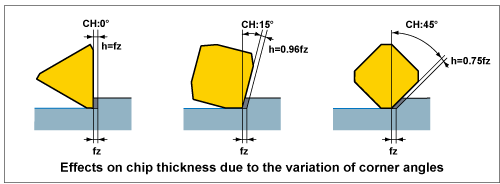
 BACK BACK |
- Technical Information
- Reference
- Function of Tool Features for Face Milling
- Corner Angle and Tool Life
FUNCTION OF TOOL FEATURES FOR FACE MILLING
CORNER ANGLE AND TOOL LIFE
Corner Angle and Chip Thickness
When the depth of cut and feed per tooth, fz, are fixed, the larger the corner angle (CH) is, then the thinner the chip thickness (h) becomes (for a 45° CH, it is approx. 75% that of a 0° CH). This can be seen in below. Therefore as the CH increases, the cutting resistance decreases resulting in longer tool life. Note however, if the chip thickness is too large then the cutting resistance can increase leading to vibrations and shortened tool life.

Corner Angle and Crater Wear
Below shows wear patterns for different corner angles. When comparing crater wear for 0° and 45° corner angles, it can be clearly seen that the crater wear for 0° corner angle is larger. This is because if the chip thickness is relatively large, the cutting resistance increases and so promotes crater wear. As the crater wear develops then cutting edge strength will reduce and lead to fracturing.
| 0° Corner Angle | 15° Corner Angle | 45° Corner Angle | |
|---|---|---|---|
| vc=330SFM Tc=69min |
 |
 |
 |
| vc=410SFM Tc=55min |
 |
 |
 |
| vc=525SFM Tc=31min |
 |
 |
 |
- Workpiece
- :AISI 4340 (287HB)
- Tool
- :D1=4.92inch
- Insert
- :M20
- Cutting Conditions
- :ap=.118inch
ae=4.33inch
fz=.008IPT - Coolant
- :Dry Cutting